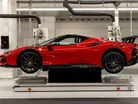Ferrari's New E-Building Boosts E-Powertrain Market Growth

Ferrari has launched a new e-building dedicated to producing its inaugural fully electric sports car. This development aligns with the industry's surge in e-powertrain manufacturing, driven by leading businesses' sustainability initiatives.
E-powertrains, which include essential components like the electric motor and inverter, eliminate the need for internal combustion engines.
Inside Ferrari's Pioneering E-Building
Establishing the e-building marks a pivotal moment in Ferrari's 77-year history, setting the stage for future sustainability projects and introducing the brand's first fully electric model.
Since 2009, Ferrari has been honing its electric technology, with the debut of its first EV scheduled for next year. Although details are still under wraps, the electric Ferrari expects to feature high-voltage batteries, EVs, and axles produced in the new e-building.
This innovative facility also includes an educational centre and reserves 30% of its space for future development and innovation. Designed to achieve NZEB (Nearly Zero Energy Building) performance, the e-building incorporates sustainable practices like rainwater recycling, irrigation of extensive green areas, and advanced insulation to manage solar radiation.
Its energy systems are entirely free of fossil fuels, and its air conditioning relies on a fully renewable electric heat pump.
Embracing Cutting-Edge Technology with UWB
Inside the e-building, industrial robots will overcome production constraints and ensure efficiency. Ferrari's Chief Digital and Data Officer, Silvia Gabrielli, highlights the integration of ultra-wideband (UWB) technology into the building's infrastructure as a critical feature.
Embracing Cutting-Edge Technology with UWB
Inside the e-building, industrial robots will overcome production constraints and ensure efficiency. Ferrari's Chief Digital and Data Officer, Silvia Gabrielli, highlights the integration of ultra-wideband (UWB) technology into the building's infrastructure as a critical feature. "We've identified the most promising technologies for the next 20 years," Silvia explains. "This includes necessary wiring to adopt UWB where it makes sense, enhancing both efficiency and safety in the manufacturing process."
The Automotive Industry's Structural Shift
Ferrari's technological advancements come at a time when the automotive industry is undergoing a significant structural shift. According to McKinsey, 70% of automotive suppliers anticipate industry consolidation over the next three to five years. Tier-one suppliers, facing cost pressures from tier-two suppliers, have limited options to pass these costs onto consumers, unlike other parts of the supply chain.
In response, companies like Bosch have entered the e-powertrain market with innovative solutions. Bosch's "start-up" e-powertrain, capable of delivering between 50 and 300 kilowatts, enables faster development and market entry for electric vehicles, including large SUVs. This system, featuring improved motor and power electronics components, offers better acceleration and sustained high speeds.
"Economically, the e-axle could be a significant success for Bosch," states Dr. Rolf Bulander, a member of the board of management of Robert Bosch GmbH and Chairman of the Mobility Solutions business sector.
McKinsey's report forecasts that by 2030, OEMs (original equipment manufacturers) will produce 70% of all e-motors in-house.
However, OEMs are pushing for aggressive annual price reductions and are hesitant to include raw-material indexes in supply contracts. It is expected to consolidate the fragmented EDU (electric drive unit) supplier market, currently served by over 20 suppliers.
The shift from internal combustion engine portfolios to e-mobility will foster the emergence of new suppliers in the EDU space, increasing competition and pressure on existing suppliers to maintain their market positions.
The trend is likely to result in higher-quality, specialised offerings tailored to specific markets, such as Ferrari's high-performance EDUs.
*******************
Make sure you check out the latest edition of EV Magazine and also sign up to our global conference series - Sustainability LIVE 2024.
*******************
EV Magazine is a BizClik brand.


